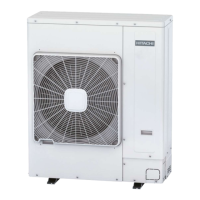3 Piping work and
refrigerant charge
64
SMGB0064 rev.0 - 08/2011
• Outdoor unit stop valve
1. Stop valve
2. Flare nut
A. Do not apply two spanners at this position. If applied, leakage
will occur
C A U T I O N
- At the test run, fully open the spindle. If not fully ope-
ned, the devices will be damaged.
- Do not attempt to turn service valve rod beyond its
stop.
- Do not loosen the stop ring. If the stop ring is loose-
ned, it is dangerous since the spindle will hop out.
- Do not apply force to the spindle valve at the end of
opening (5 Nm or smaller). The back seat construction.
1
2
A
• Evacuation and refrigerant charge
- Connect the gauge manifold using charging hoses with a vacuum pump or a nitrogen cylinder to the check joints of
the liquid line and the gas line stop valve.
- Check for any gas leakage at the are nut connection, by using nitrogen gas to increase the pressure at 4.15 MPa
for outdoor units inside of the eld-supplied piping.
- Operate the vacuum pump for 1 to 2 hours until the pressure decreases lower than a pressure of 756 mmHg in
vacuum.
- For charging refrigerant, connect the gauge manifold using charging hoses with a refrigerant charging cylinder to
the check joint of the liquid line stop valve.
- Charge the proper quantity of refrigerant according to the piping length (Calculate the quantity of the refrigerant
charge).
- Fully open the gas line stop valve, and slightly open the liquid line stop valve.
- Charge refrigerant by opening the gauge manifold valve.
- Charge the required refrigerant within the difference range of ±0.5 kg by operating the system in cooling.
- Fully open the liquid line stop valve after completing refrigerant charge.
- Continue cooling operation for more than 10 minutes to circulate the refrigerant.
- See the example below.

